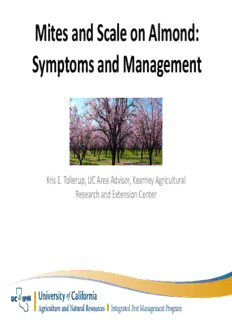
Mites and Scale on Almond PDF
Preview Mites and Scale on Almond
Mites and Scale on Almond: Symptoms and Management Kris E. Tollerup, UC Area Advisor, Kearney Agricultural Research and Extension Center Monitoring • Critical component of management – Identification of pest and associated damage. – Estimate population density of pest • Provides decision-making tool. – Some level of pest/damage is tolerated i.e. below on economic injury level • Pest and crop dependent. • Decrease as crop value increases/pesticides decrease. Spider Mites • T etranychus spp. – Pacific spider mite • T. pacificus. – Twospotted spider mite • T. urticae. – Strawberry spider mite • T. turkestani. Male Morphological Characteristics Spider Mites, Injury and Damage • F eed using a stylophore – Punctures cells, mite sucks out content causing stippling. – Browning of leaves. – Defoliation • MAY: reduce fruit quality following year due to Reduced photosynthesis • Sunburn of wood. – Plant stress due to evapotranspiration. Management, Natural Enemies • Predatory mites – Galendromus sp. – Neoseiulus spp. • Lacewing – Chrysoperla spp. • Sixspotted thrips – Scolothirps sp. • Spider mite destroyer – Stethorus spp. Management, Natural Enemies Type 4 Type 3 Type 2 Euseius stipulatus Galendromus occidentalis Metaseiulus citri Euseius tularensis Typhlodromus caudiglans Neoseiulus californicus Predatory Mite Food Type Type 4 Type 3 Type 2 Mites + insects + Mites + insects + Web-spinning pollen + leaf sap pollen spider mites Euseius Amblyseius Galendromus quetzali similoides occidentalis Euseius Metaseiulus Neoseiulus stipulatus citri barkeri? Euseius Typhlodromus Neoseiulus tularensis caudiglans californicus
Description: